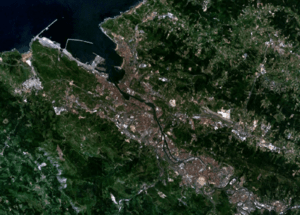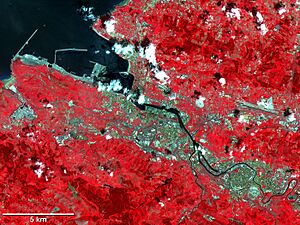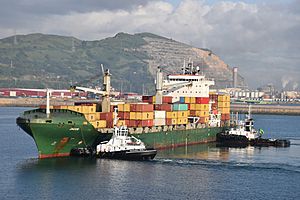Port of Bilbao facts for kids
Quick facts for kids Port of BilbaoPuerto de Bilbao / Bilboko portua |
|
|---|---|
 |
|
| Location | |
| Country | Spain |
| Location | Bilbao, Basque Country |
| Coordinates | 43.3524°N 3.0489°W |
| Details | |
| Opened | 1300 |
| Operated by | Ports of the State |
| Owned by | Bilbaoport |
| Type of harbor | International |
| Size | 17 km |
| Statistics | |
| Annual cargo tonnage | 32.1 million tonnes (2016) |
| Annual container volume | 596,688 TEU (2016) |
| Value of cargo | 65.2 million EUR (2016) |
| Website https://www.bilbaoport.eus |
|
The Port of Bilbao is a very important port in Spain. It is located on the Bilbao Abra bay and along the Estuary of Bilbao. You can find it in Biscay, which is part of the Basque Country. The main parts of the port are in the towns of Santurtzi and Zierbena. These towns are about 15 kilometers (9.3 miles) west of the city of Bilbao.
People sometimes call this port the Exterior Port or the Superpuerto. The port area is huge! It covers about 3.13 square kilometers (773 acres) of land. It also includes 16.94 square kilometers (4,186 acres) of water. The waterfront stretches for 17 kilometers (10.6 miles).
Contents
History of the Port of Bilbao
The story of the Port of Bilbao is closely connected to the history of Bilbao city itself. So, the port started at the same time the city was founded.
Early Days of the Port (1300s)
In the year 1300, Bilbao became an official city. This meant it could control all the ships and goods moving in and out of its estuary. The first docks were built in Bilbao's old town. This was about 15 kilometers (9.3 miles) from the open sea. These docks were the main center for port activities for over 500 years.
In 1511, the port received a special permission called the Consulate of Bilbao. This allowed the port to control the routes for exporting wool to northern Europe.
Growth and Challenges in the 1800s
During the 1800s, people found a lot of iron ore nearby. This discovery helped the area's industries grow very quickly. The estuary of Bilbao became home to many steel and shipbuilding companies. The docks expanded from Bilbao all the way to the bay.
However, ships needed the river to be easy to navigate. The engineer Evaristo Churruca created a huge plan to fix the river's problems.
- There were dangerous sand banks that often changed the river's path.
- The river had many tricky bends.
- There were large marshy areas.
- Storms from the Bay of Biscay often flooded the river's mouth.
Churruca's plan involved draining the river banks and building new docks. The river's path was made straighter. The outer part of the port was enclosed. Also, the famous Puente Colgante transporter bridge was built.
Bilbao Becomes Spain's Biggest Port
By 1900, Bilbao had become the biggest port in Spain. This helped the region's economy grow very fast. Shipyards and steel mills lined the riverbanks. In the 1970s, the Santurtzi area was developed. The Deusto channel was also created.
The Modern Superpuerto Project
Over time, industries changed, and some docks were no longer used. Also, ships became much bigger. Large tankers and freighters could not enter the river anymore. The Santurtzi area became too crowded.
So, in 1975, a big project called the Superpuerto was started. The idea is to eventually enclose the entire Abra Bay with docks. This huge project is still ongoing today.
Shipping Activities at the Port
The Port of Bilbao handles a lot of goods. In 2007, it handled over half a million TEUs (twenty-foot equivalent units) of containers. A TEU is a standard size for shipping containers.
The Port of Bilbao is the 4th busiest port in Spain. It is behind Algeciras, Barcelona, and Valencia. It is also Spain's largest port by area.
Since 1998, the port has grown a lot in size. This has led to much more ship traffic.
Rail Connections
The port uses the RENFE railroad to move goods. However, a new rail connection is needed. The current train line is also used by local commuter trains. It also goes through a very busy city area. People are thinking about building a high-speed train connection. But Spain's current high-speed network is not designed for cargo trains.
Cruise Ships and Tourism
A new dock was built in Getxo for cruise ships. More and more cruise ships are coming to Bilbao. This is largely because the Guggenheim Museum Bilbao opened in 1997. The museum brought many more tourists to the city. It also put Bilbao on the map for cruise ship routes.
Ferry Services
Ferries are ships that carry both passengers and vehicles.
In September 2010, Brittany Ferries announced they would take over the Portsmouth-Bilbao route. They started this service on March 27, 2011, using the MV Cap Finistère. This route joined their other services from Portsmouth/Portsmouth International Port to Santander, and from Plymouth to Santander.
Before that, from May 1993 to September 2010, P&O Ferries offered this service with the Pride of Bilbao.
Between May 2006 and January 2007, another company called Acciona Trasmediterránea also ran a service using the MV Fortuny.
Ferry Destinations
You can take a ferry from the Port of Bilbao to these places:
- Portsmouth in the UK (with Brittany Ferries)
- Roscoff in France (with Brittany Ferries)
- Rosslare in Ireland (with Brittany Ferries)
Environmental Concerns
Some people are worried about the huge project to make the outer port bigger. Ecologist groups are protesting. They are concerned because large parts of the bay are being covered by new docks. Also, nearby hills are being dynamited to get materials for building these new docks.
Port Statistics
| Port Statistics | |||||||
|---|---|---|---|---|---|---|---|
| Year | Annual Cargo | Liquid | Containers | Passengers | Vessels | Cruises | |
|
|
|||||||
| 2000 | 28,633,903 | 14,764,295 | 434,333 | 129,631 | 3,796 | ||
| 2001 | 27,100,442 | 14,325,857 | 454,382 | 134,954 | 3,845 | 17 | |
| 2002 | 26,257,108 | 13,125,429 | 455,019 | 138,852 | 3,673 | 19 | |
| 2003 | 28,099,276 | 15,662,945 | 453,763 | 111,622 | 3,458 | 17 | |
| 2004 | 33,214,274 | 18,598,894 | 468,959 | 144,677 | 3.710 | 21 | |
| 2005 | 34,100,494 | 19,684,506 | 503,811 | 177,795 | 3,583 | 21 | |
| 2006 | 38,590,827 | 22,289,779 | 523,113 | 185,388 | 3,683 | 21 | |
| 2007 | 40,014,326 | 22,682,181 | 554,568 | 172,626 | 3,595 | 21 | |
| 2008 | 39,397,938 | 23,057,334 | 557,355 | 179,572 | 3,585 | 38 | |
- Annual Cargo: This is the total weight of all goods moved through the port in tons.
- Liquid: This refers to liquid cargo in tons. It includes things like petroleum and LNG (liquefied natural gas) handled at the Petronor and BBG terminals.
- Containers: This counts the number of containers handled at the ATM and TMB terminals. It is measured in TEUs.
- Passengers: This is the number of passengers who traveled by the MV Cap Finistère ferry of Brittany Ferries to Portsmouth.
- Vessels: This is the number of ships that docked at the port.
- Cruises: This counts the cruise ships that docked in Getxo. Before 2006, cruise ships used to anchor in Santurtzi.
See also
 In Spanish: Puerto de Bilbao para niños
In Spanish: Puerto de Bilbao para niños



